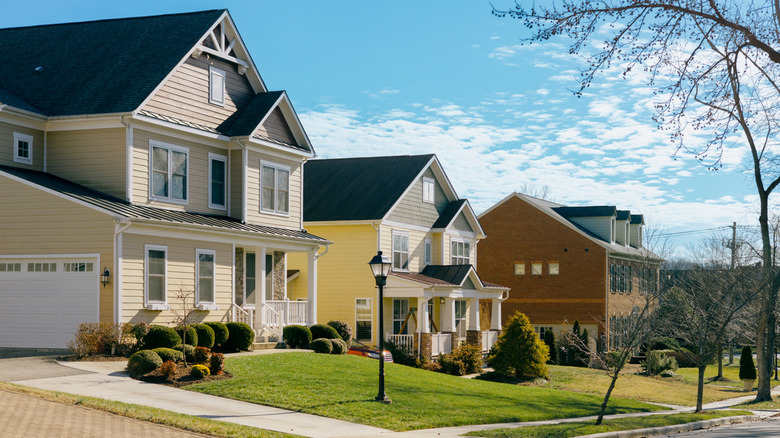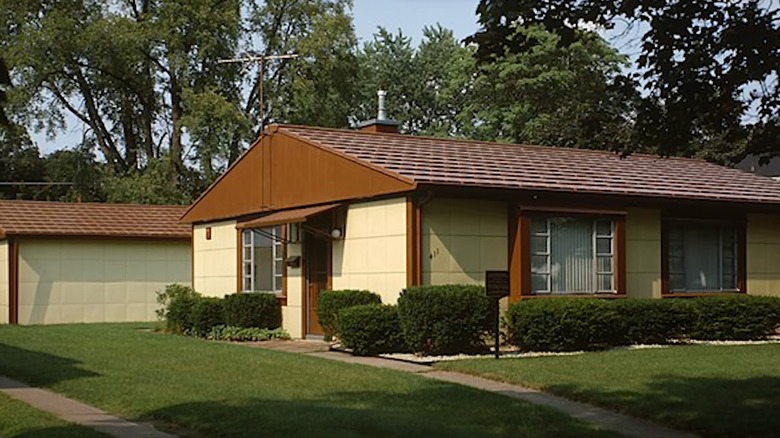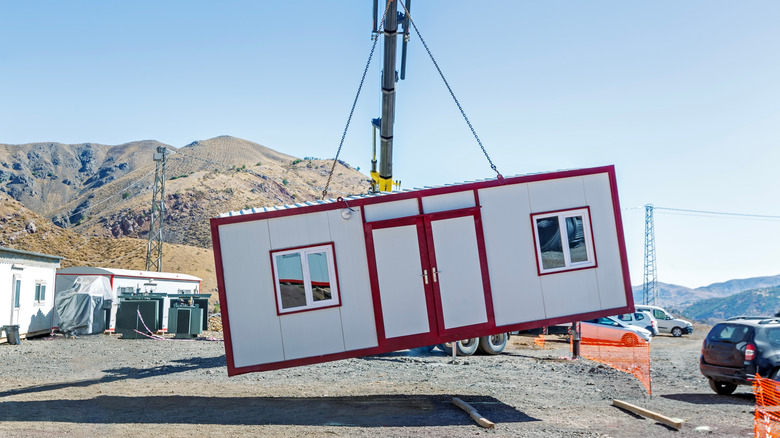The Outdated Home Type From The 1940s That Deserves A Comeback
Driving down the street of any town or suburb, you'll find a variety of different home styles or the same cookie cutter house on repeat. However, there are some seemingly outdated home styles that we don't often see that deserve another chance to shine. One unique home that could make a modern comeback is a post-World War II special from the 1940s. Known as the Lustron home, there are an estimated 1,500 of these modern-meets-minimalist homes that still exist today.
These homes were a solution to the post-war housing crisis and a shortage of materials typically used for building. Entrepreneur Carl Strandlund came up with a plan to build homes made of steel coated with a porcelain enamel. These were prefabricated homes that were built using more than 3,000 parts. Often, they looked like a ranch style house, although the porcelain enamel walls made them stand out from the crowd.
Lustron homes were advertised as being fire proof, rust proof, and even rodent proof. They would be shipped to the buyers wherever they wanted them, and were assembled on property. Even the interior walls and cabinets were made with steel, making these homes unique when it came to decorating, as they did not need to be painted and many homeowners turned to magnets to hang art and decor on the walls. With these homes, you could choose between two and three bedrooms, as well as a number of other features to make it your own.
What are some downsides of a Lustron Home
Although Lustron offered a unique approach to prefab homes at the time, that doesn't mean they were perfect. It's hard to repair or remodel this type of home because everything was custom made. These homes are also hard to paint because of the porcelain enamel on the exterior of the steel. Many of today's contractors are likely unfamiliar with the Lustron, as only around 2,500 were ever produced to begin with. This means getting things fixed can be a challenge. Getting replacements for pieces that break can be next to impossible. As a result, it can be expensive to upgrade or fix things that wear out over time.
Even the way these homes are heated is unique. There are no ducts for heating or cooling systems in Lustron homes. Instead, they use a form of radiant heat that flows down from the ceilings to warm the rooms. This can actually lead to cooler temperatures near the floors, as heat tends to rise. Changing the heating system is not often recommended, as that can lead to an even more complex set of issues.
These are also considered smaller homes, as they're around 1,000 square feet. Compared to many modern builds, these homes are relatively cramped. At the same time, they're still bigger than today's tiny homes. While there is certainly room for a small family, they might not work for everyone.
How to modernize a Lustron home
Lustron homes stopped being built in the 1950s, but they have a lot going for them even now. This style of home making a comeback could potentially offer new homebuyers a chance to live in the type of tiny home they always wanted while still giving them plenty of space. As a prefab home, it can be a more affordable option for people looking to have a home built on land they may already own. Bringing back this home style would likely require some modernization, however.
Typical Lustron homes are not open concept, which is something that many modern homebuyers and builders are looking for in their designs. Once a wall is in place in these homes, that's where it stays, but since these homes are customizable, it would make sense that in planning you might opt for a layout that allows the kitchen, dining, and living rooms to be visible and connected. Even upgrading the kitchen with new appliances and changing out the cabinets would make a difference in the feel of one of these buildings.
Smart technology integrations, new light fixtures, stylish door knobs, or even upgraded drawer pulls could go a long way in making these spaces feel less like a time capsule. These simple tweaks would work in already built Lustron homes, but changes to the vintage design could also help draw in new customers that are willing to try out and reinvigorate this unique prefab style. Small changes could make a big difference in making these 1940s era homes new again, and who knows — maybe this post-war style could see a resurgence with a modern audience.


